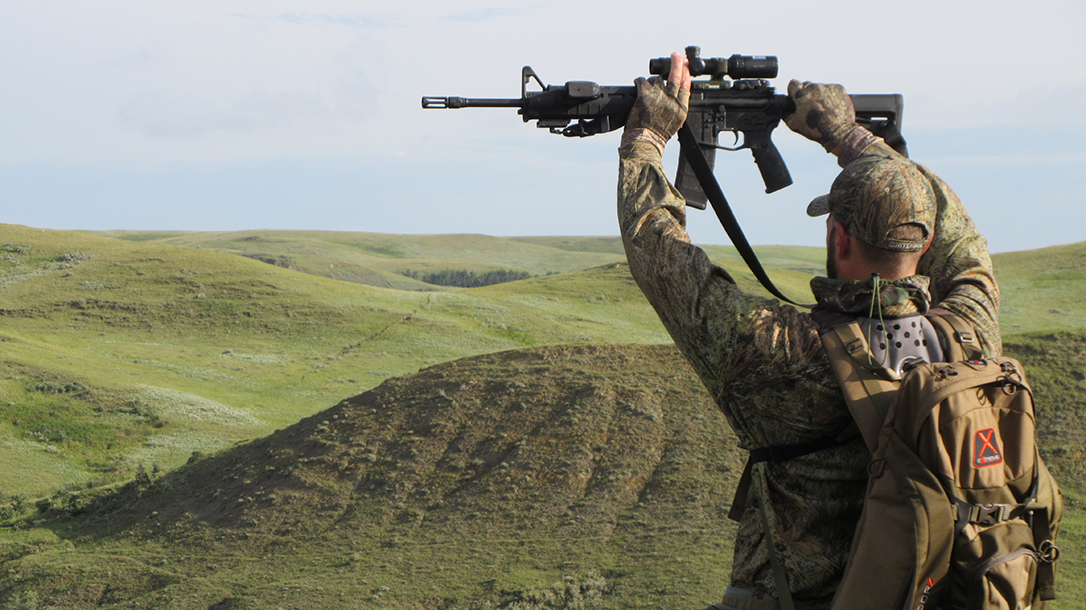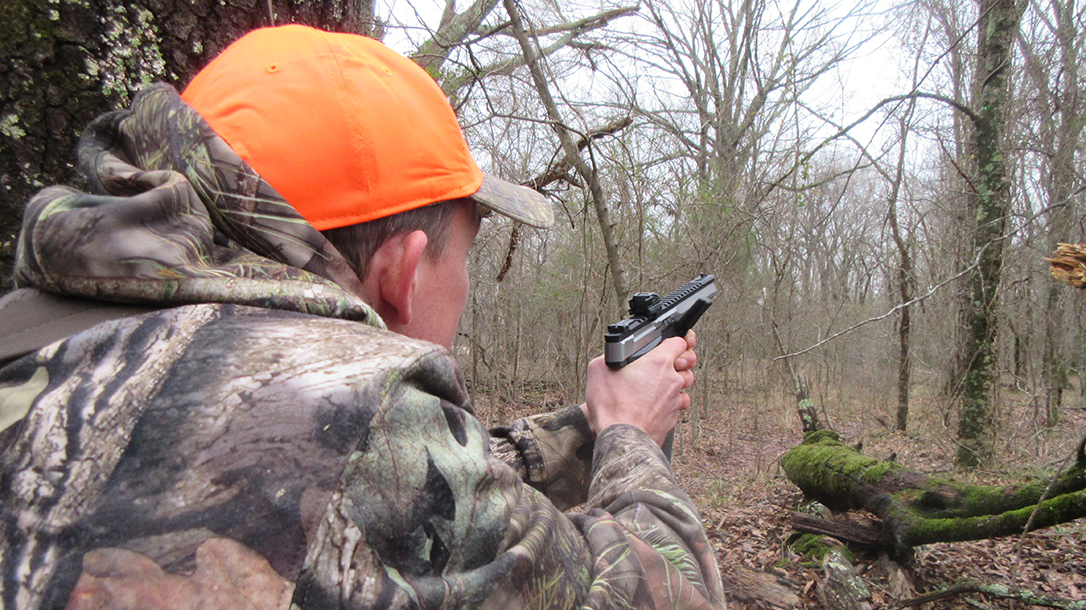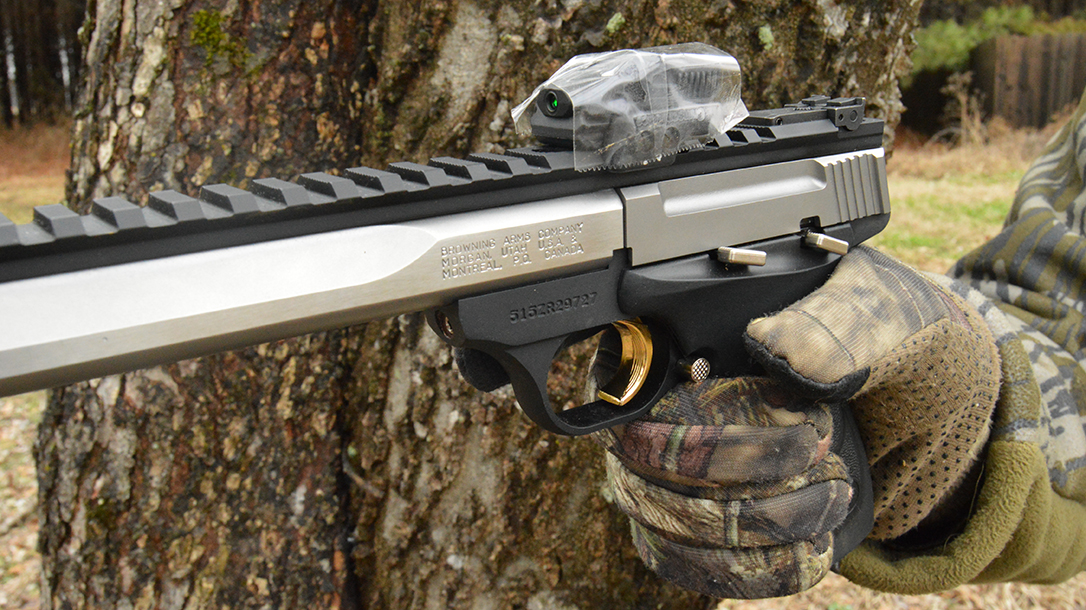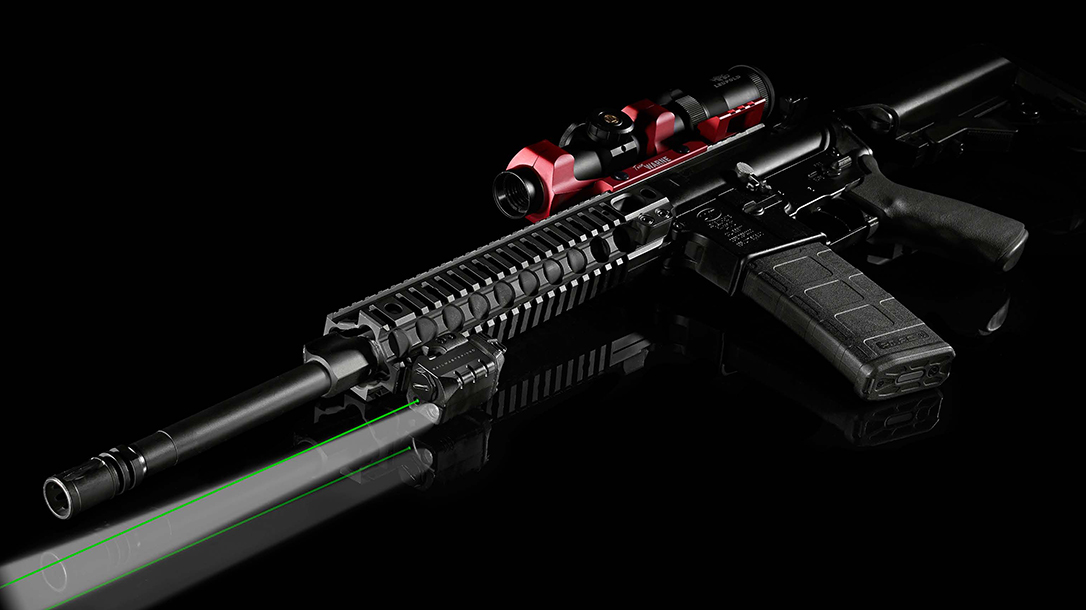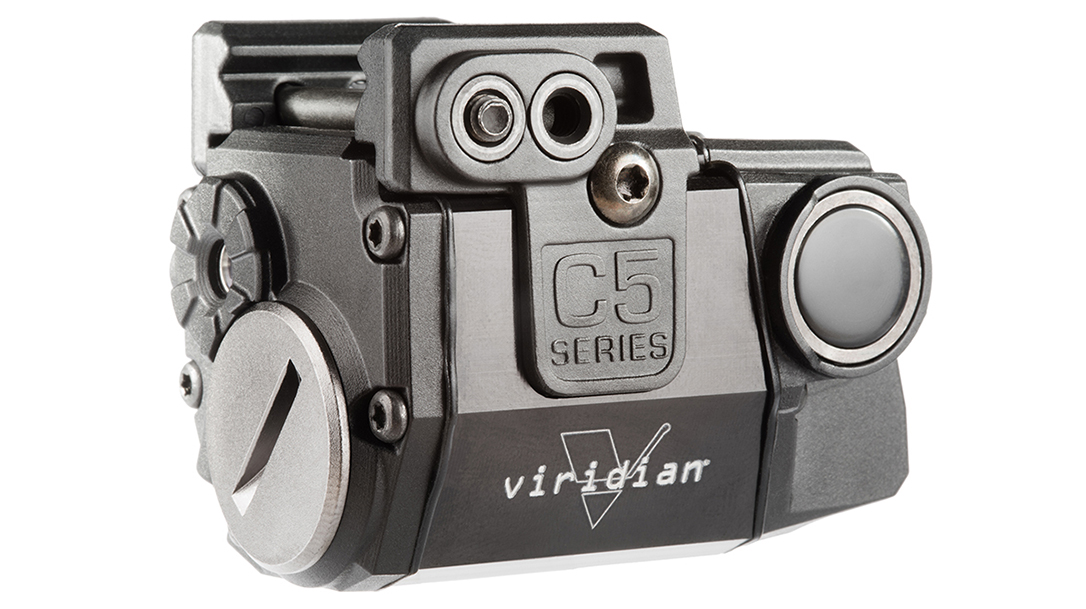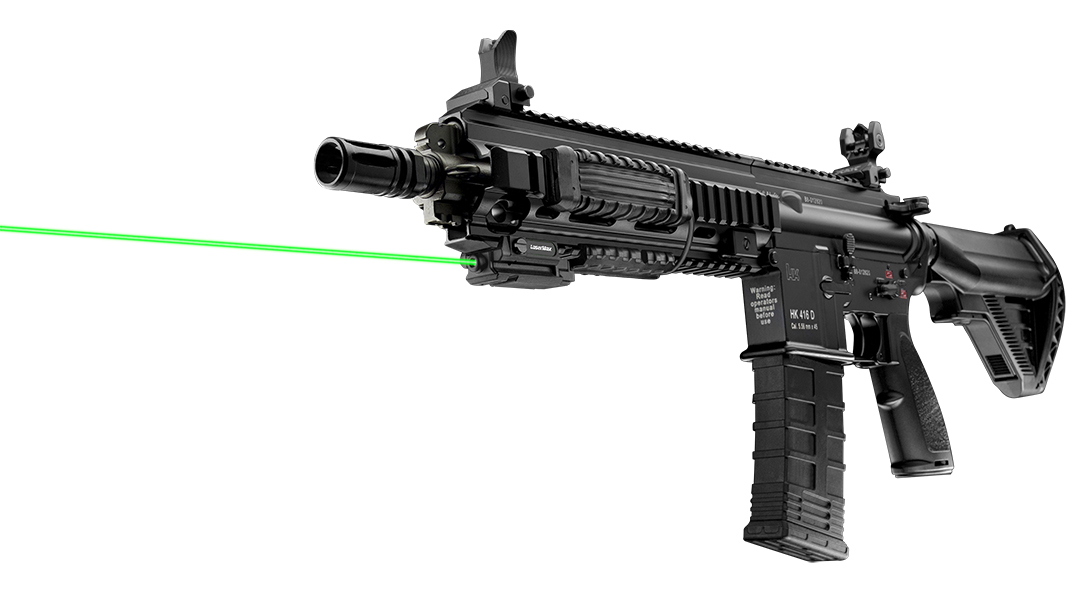While the use of laser sights for hunting is still relatively uncommon, there is ample reason to expect their use to expand. At present, most states don’t permit the use of lasers or lights on firearms when hunting protected big game such as deer, but most states allow their use for hunting wild hogs (and other pest animals) and about half the states allow them for small game. Laser sight purchases have easily doubled in the last decade. Though most laser sights are ending up on personal defense handguns and tactical rifles, the same things that make the lasers useful on these firearms apply to hunting guns.
Laser Sights for Hunting: Pros & Cons
Among the benefits are more confident target acquisition (particularly in low light); the ability to focus the eyes entirely on the target area, which is beneficial for following the movement of your target animal as well as a great help to aging eyes. The ability to aim the firearm accurately in a “heads-up” manner, rather than with the traditional marksmanship holds we use to shoot with iron sights and scopes. The laser can also be used to point out game to other hunters, and the visual indication of the bullet’s impact point is a constant reminder of the need for safe gun handling and muzzle control.
Advertisement — Continue Reading Below
The downside is that the laser’s maximum range is limited by both its power and (more likely) your eyesight. Laser light is diffused somewhat by humidity in the air (rain or fog). The point of impact is less precise the farther you get from your target, and it can be difficult to spot the laser dot in bright light. Laser sights require batteries and most are not waterproof. Lasers aren’t yet universally legal for hunting in all states, either. Hunters need to check their own state’s specific laws before using them.
Lasers have a definite place on hunting rifles, handguns, shotguns and bows for use on terrestrial animals large and small, as well as fish. Duck hunting, or any other wingshooting, is out though. There’s no way to see the laser dot against the sky to track a bird in flight, and aiming your laser skyward is a threat to civil aviation. In addition, if you are good enough to put a laser on a flying bird, you don’t need a laser sight.
Where They Shine
Laser sights can be a significant advantage in the woods, in dimmer light and heavy cover, but lasers also have night hunting applications (for example, for raccoons, foxes and wild pigs) where conventional scopes and sights would be difficult to use. The laser excels on the hunt for terrestrial animals at ranges you would normally shoot with open sights, 100 yards or less.
Advertisement — Continue Reading Below
There’s no magnification or optical enhancement of any kind with a laser sight, only your natural visual acuity and the laser dot. If you can’t see the game with your eyes, a laser isn’t going to help you at all. However, most older hunters don’t have trouble seeing the game. They have trouble seeing the iron sights, and this is where a laser sight shines. Because it puts target and aiming point in the same distant focal plane, it compensates for the loss of close focus that typically affects human eyes as they age.
People under 40, have you ever wondered who’s buying all those reading glasses on display in every pharmacy and big box store? You get farsighted as you get older, and this can make it very hard, if not impossible, to see your rear sight clearly enough to get a good sight picture with open sights. (Aperture sights can still be more or less usable, since the rear sight is supposed to be out of focus anyway.)
Growing Dot
If you wanted to have a magnified view of your target, there’s no reason you couldn’t use a telescopic sight in conjunction with a side- or bottom-mounted laser sight. This would partially negate the situational awareness the laser allows, in return for some greater precision. I say some, because the front of the laser beam fans out more the farther away it goes. The beam is typically 0.5-inch diameter spot at 50 feet. I measured it at 50 yards and found it grew into a fat ellipse over 2 inches at its widest point. The green laser will project over 100 yards in sunlight, but that dot is going to get even bigger.
Advertisement — Continue Reading Below
The growing dot phenomenon begs the question: Do the animals notice the laser? I suspect they do, but not in the spectacular way we see it. They get shafts of light penetrating the forest canopy and shining on their bodies, so a laser dot doesn’t seem like it should be so unique. I would not make a point to shine it in their eyes. That might get their attention, annoy them and cause them leave before you can shoot.
Pistol Hunting
Laser sights seem particularly good for pistol hunting, where the ranges are closer. Further, I find that not having to get down on the iron sights or scope in a traditional marksmanship pose allows me to shoot from more comfortable and stable heads-up positions. When you elevate your head over the iron sights, the laser dot appears to rise over them too, and this is one of the advantages of the laser in the field.
Unlike traditional marksmanship, which concentrates on maintaining perfect sight alignment while taking aim at the target, shooting with a laser sight is all about watching the dot. I’ve hunted squirrels from a seated position resting the barrel on a little Polecat shooting stick with my arms steadied on my knees. Initially, I had a little trouble spotting my laser dot because the trees were bare and a lot of sky was showing. The solution was to aim at the ground in front of me and “walk” the laser right up to the target. It actually takes more time to describe than it does to do it.
Advertisement — Continue Reading Below
Red Or Green?
The color of your laser is important. Red lasers are the least expensive, have the longest battery life and are excellent for close-range defensive shooting. In daylight on the range, I find them hard to spot at 25 yards. The newer green lasers are the best choice for hunters. They really pop out to the eye downrange, even in sunlight. That’s because our eyes see green light wavelengths much better than red ones. The green lasers are more complex to make and retail for about 25 percent more than red. Going green will also use up your battery power about twice as fast, but this is really a non-issue while hunting because there’s no reason to turn the laser sight on until you are preparing to aim your gun. Whether you have two hours or four hours of battery is not going to matter during the course of a season.
Most laser sights are designed to attach to Picatinny or Weaver rails, which is great if you have a tactical rifle, shotgun or pistol. Most traditional (bolt-action) hunting rifles and shotguns will need a rail attached before they can mount a laser. If it’s a newer gun, it’s possible the scope mounts are already attached to small sections of rail screwed onto the receiver. That makes mounting the laser a snap. Take off the scope and rings, mount the laser to the same base, tighten it up and sight in.
Crimson Trace
By far the largest laser sight manufacturer, and the market leader, is Oregon-based Crimson Trace Corporation (crimsontrace.com). They have the broadest range of green laser options for hunters. Their compact, lightweight plastic housing Rail Master green laser (CMR-206) was designed to fit in front of a pistol’s triggerguard on a rail. It is turned on by tapping a small paddle on either side of the case. MSRP on this sight is $199, but I’ve seen it at major retailers for as low as $159.99. This is an excellent sight at an entry-level price.
Advertisement — Continue Reading Below
Mounting it on top of your gun requires it to be upside down. This doesn’t affect its function, but it might make it more susceptible to rain since the battery cover will be facing up. As a precaution, just cover it with a piece of clear packing tape to keep it dry. Just don’t obstruct the beam. They also make a J-frame green laser grip (LG-350G, MSRP $399) ideal for the .22 Kit Gun (the laser mounted in the right-side grip panel), but none yet for the popular larger-frame hunting revolvers.
Light & Laser
If you want to get a little more sophisticated, Crimson Trace makes the Rail Master Pro (CMR-204) which is boxy, slightly larger and heavier (its case is made of aluminum) because it includes a 100-lumen white LED light, which can be operated alone or in conjunction with the laser. The light and laser combo would be great for raccoon hunting at night with a pistol or rifle, but some might find this unit a little too big for mounting on the top rail of a traditional sporting long gun or pistol. It would be perfectly at home attached to the tactical rail near the muzzle of a modern sporting rifle. The CMR-204 has an MSRP of $379, but I have seen it advertised for $350.
Advertisement — Continue Reading Below
Going Green
Crimson Trace has three great rail-mounted combination green laser and light products specifically for railed-up modern sporting rifle platforms that are out-of-the-box perfect for hunters who prefer these rifles. The new CMR-300 is like the CMR-204, with a brighter 300-lumen light and an on-off button on the back. MSRP is $249. This would be commonly mounted on the bottom rail near the muzzle, which means you’ll have to reach forward to activate it.
To address this minor inconvenience, Crimson Trace created a new wireless radio signal-operated unit called the LiNQ system. The LNQ-100G requires substitution of your normal pistol grip with the LiNQ grip, which houses all the light and laser controls so there’s no need to move your hands from firing position. Otherwise it uses the same green laser and 300-lumen white LED light as the CMR-300. MSRP is $429, but I have found it as low as $384 on sale. There’s also a LiNQ system for the AK platform.
The final laser/light combo from Crimson Trace looks more at home on a tactical rifle than a hunting gun, but consider that your AR carbines, especially in 300 Blackout, are popular for tough wild hogs. The Crimson Trace MVT-515G is an extremely rugged aluminum and polymer vertical foregrip that houses the laser and a 200-lumen white light. Also, the controls are ambidextrous, and the light operates in momentary and constant-on mode, with or without the laser. MSRP is $649, but I have seen it as low as $575. By the way, all these lasers/lights have a strobe setting if you needed to use them in conjunction with the laser in a defensive situation.
Advertisement — Continue Reading Below
Other Green Lasers
Crimson Trace is the biggest game in town, but they aren’t the only one. Four other rail-mounted green laser sights worth a look are made by Viridian (viridianweapontech.com) and LaserMax (lasermax.com). Viridian’s rugged C5 Universal Subcompact Green Laser has an MSRP of $279. Additionally, the C5L adds a white light in the same size unit (MSRP $349). Viridian has a seven-year warranty too, the longest in the industry. LaserMax’s Green Uni-Max Laser (MSRP $309) has the lowest profile, operated by direct-wired remote trigger, and has a rail of its own so you can stack something else on top of it. Finally, LaserMax’s Green Micro II is the shortest rail-mounted laser, with an MSRP of $169.
Trigger control and a steady hand are still critical to successfully hitting the target, but the visual challenges of iron sights and low light, and even some physical limitations, can be partly overcome with the use of laser sights. Also, for younger hunters with first-person-shooter video game experience, lasers will seem perfectly natural, and new or occasional hunters will find a laser increases their confidence and success within the laser’s effective range. Above all, hogs, little varmints and some deer, beware.
This article is from the 2019 Modern Guns issue of Tactical-Life magazine. Grab your copy at OutdoorGroupStore.com. For digital editions, visit Amazon.
Advertisement — Continue Reading Below
